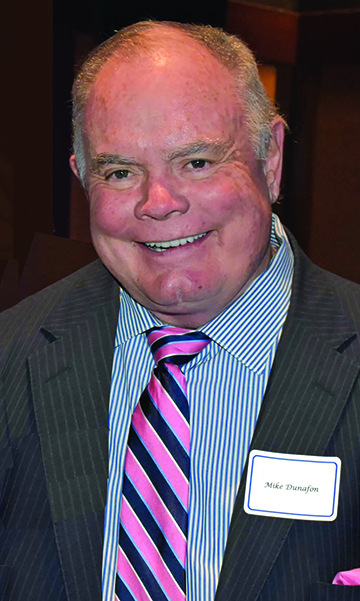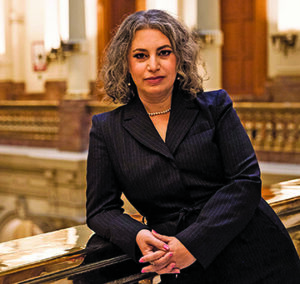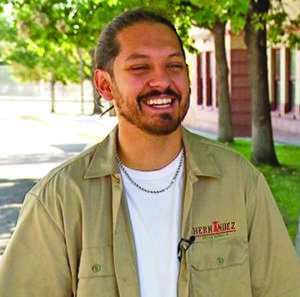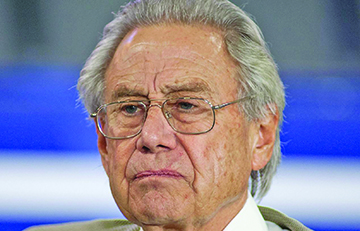
by Charles Bonniwell | Oct 18, 2024 | Main Articles
Split Decision After Millions Spent And No Fine
by Charles C. Bonniwell

Another Defeat: Mohammad Ali Kheirkhahi one of the principals of MAK faced another defeat when the IEC declined to fine Mayor Mike Dunafon in the case MAK brought against him a decade ago in the IEC.
 After a decade and millions of dollars spent, the Colorado Independent Ethics Commission (the “IEC”) has finally rendered a decision concerning a February 3, 2015, Glendale City Council meeting. The IEC ruled in a split decision that Glendale Mayor, Mike Dunafon, violated Colorado law when he failed to publicly announce at that meeting and two subsequent council meetings that his girlfriend of 15 years, Debbie Matthews, was his girlfriend, notwithstanding the fact everyone in Glendale and at the meeting already knew that fact.
After a decade and millions of dollars spent, the Colorado Independent Ethics Commission (the “IEC”) has finally rendered a decision concerning a February 3, 2015, Glendale City Council meeting. The IEC ruled in a split decision that Glendale Mayor, Mike Dunafon, violated Colorado law when he failed to publicly announce at that meeting and two subsequent council meetings that his girlfriend of 15 years, Debbie Matthews, was his girlfriend, notwithstanding the fact everyone in Glendale and at the meeting already knew that fact.
The Council Meeting
Ms. Matthews had presented a development site plan for a marijuana dispensary next to the nightclub Shotgun Willie’s to the Council. She was the majority owner of both businesses. The IEC found that Mr. Dunafon did not have “a personal or financial interest” in Ms. Matthews’ businesses, nor did he “attempt to influence the other members of the Glendale City Council” regarding Ms. Matthews’ businesses.
But the majority of the IEC declared that Dunafon violated C.R.S. Sec.24-18-109(3)(a) in that he had a “personal or private interest” in Ms. Matthews, and therefore her businesses, and had to publicly declare and disclose that his long-term girlfriend Ms. Matthews was, in fact, his girlfriend.
The IEC declared that no fine would be imposed because of the violation.
In a dissent, Commissioner Cole Wist pointed out that there was no definition of “personal or private interest” which could mean virtually anything. He suggested that it had to mean a “pecuniary” interest. He pointed out in a small town like Glendale (pop. 4496) almost any matter will involve people council members know. Explaining in public any or all connections would be a monumental waste of time and always be subject to second-guessing by anyone unhappy with a decision.
The Backstory
One of the first questions asked by observers of the IEC is why this relatively simple, if strange, decision took the IEC a decade to decide and cost millions of dollars in attorney’s fees and costs for the parties to the litigation. The reason is that nothing in the dark and byzantine world of the IEC is what it appears to be.
The IEC was formed as part of constitutional Initiative 41 titled “Ethics in Government. It was the brainchild of multimillionaire, and now Governor, Jared Polis. It was sold to the voters as a way to strictly limit gifts and gratuities to elected officials. The limitations would be lightly overseen by an independent ethics commission composed of citizens appointed by different political bodies and officeholders.
The IEC was to have a very limited staff and very limited powers. But as with many bureaucratic entities, the IEC has over the years endlessly sought to gain ever expanding powers and potential control over a significant portion of the Colorado citizenry.
It has become a boutique place where political insiders can bring to heel their political enemies which have included the Colorado Secretary of State and even a Governor of Colorado.
Being a boutique operation, the IEC does not have to take any case it doesn’t want to. It can dismiss cases because of “lack of jurisdiction” or it being “frivolous” with no explanation for the decision.
The Glendale Case

Winning Resolve: Glendale Mayor Mike Dunafon and the City of Glendale continue to refuse to give into the tactics of the IEC.
The Glendale case in the IEC had its genesis in a political war started by the Iranian owners (MAK Investors) of Authentic Persian and Oriental Rugs at the corner of Colorado Boulevard and Virginia Avenue. MAK wanted to take the 5.4 acres of land it had acquired from its landlord and make a fortune by building huge skyscraper apartment houses and condominiums along Cherry Creek.
The only problem was the land was not zoned for such development and their project was widely opposed by Glendale residents. MAK, used to playing extreme hardball to get what it wanted, commenced a war with the town’s mayor, Mike Dunafon, and the City Council. MAK hired the powerhouse law firm of Ireland Stapleton to bring a myriad of highly expensive lawsuits in state and federal courts against the city. MAK also hired the far right-wing paramilitary group The Oath Keepers to march fully armed through the streets of Glendale to intimidate the citizens and then to march to City Hall to harass the mayor and city council at a council meeting.
The rug merchants also went to the Denver FBI, who were rumored to have informants and agents within The Oath Keepers, to see if it could get the federal government involved to pressure Glendale to grant the rezoning MAK needed for its skyscrapers.
MAK, after years of litigation, lost all of its lawsuits brought by Ireland Stapleton and the city continued to refuse MAK’s rezoning demands. But MAK had one more arrow in its quiver. Bernie Buescher, a lawyer at Ireland Stapleton, had been Acting Secretary of State of Colorado and was reputed to know how to use the IEC to attack political enemies.
MAK poured over the minutes of the meetings of Glendale City Council to try to find anything it could use for a complaint to the IEC. MAK came across the February 3, 2015, minutes and thought they could use it in the MAK battle plan to force a rezoning for its skyscrapers.
MAK brought its complaint to the IEC almost a decade ago.
IEC’s Interest In Glendale Case
The IEC itself had no real interest in MAK’s push to make Glendale rezone its property but took the case, and is believed, to be a political favor to Bernie Buescher. However, the IEC came to see the Glendale case and saw it as a vehicle to expand its power over home rule counties and municipalities in Colorado, which includes almost all larger cities and counties in the State.
The major impediment to the expansion of IEC power was the express provision in Section 7 of the enabling provision which states:
“Any county or municipality may adopt ordinances or charter provisions with respect to ethics matters that are more stringent than any of the provisions contained in this article. The requirements of this article shall not apply to home rule counties or home rule municipalities that have adopted charters, ordinances, or resolutions that address the matters covered by this article.”
To get around this limitation to its powers the IEC came up with a strategy to accept cases against elected officials from small municipalities and counties that had their own ethics codes, since these entities do not have millions of dollars to fight off a claim of IEC jurisdiction over them.
Infamously the IEC went after County Commissioner Julie Cozad from a home rule county. To receive a plea deal, the IEC got her to concede the IEC had jurisdiction over the county.
The IEC then decided to accept a case concerning Dunafon as a mayor of a small home rule city assuming a small town like Glendale (pop. 4,496) would not have the resources to protect its own mayor on the jurisdiction question. But the IEC was badly mistaken as Glendale has an extremely large tax base for a small city and a history of fighting off governmental bullies like the IEC. Now, 10 years and millions of dollars spent, Glendale forced the IEC to make a ruling. Some IEC observers wondered why the IEC imposed no penalty against Mayor Dunafon even though it found a violation. Was the IEC trying to be magnanimous? The IEC was most likely anxious to penalize Dunafon to the maximum amount possible. But if it imposed a fine, no matter how small, its actions could be subject to review by the courts.
The IEC Wants To
Avoid The Courts At All Costs
The IEC has asserted that as the IEC was created by an amendment to the State Constitution, state laws and the state legislature have no power to constrain the IEC. The IEC asserts that no ethics rules apply, including the Colorado Open Record Act and Colorado Open Meetings Act. Thus, it believes only the Colorado judiciary could possibly limit its power grab and thus the courts must be avoided at all costs.
With a decision made in the Glendale case it would normally be subject to judicial review. But the IEC came up with an ingenious legal argument that the court could review decisions only in cases that the IEC imposes a penalty. In the Glendale case the IEC has argued that since it imposed no fine on Mayor Dunafon no court could review the Glendale case.
Ever More Litigation
Glendale does not intend to give in to such legal sophistry and now has brought an action under Section 106 of the Colorado Rules of Civil Procedure to a Colorado District Court on whether the IEC has jurisdiction over home rule cities.
Whatever the District Court rules, the decision will be appealed to the Colorado Court of Appeals and then eventually to the Colorado Supreme Court. Is decades of litigation and millions in attorney fees and costs what the Colorado voters envisioned when it approved the “Ethics in Government Act” in 2006?
Probably not, but as Lord Acton noted, power corrupts and absolute power corrupts absolutely. The IEC in seeking a form of absolute power is revealing how corrupt the IEC has become.

by Charles Bonniwell | Apr 19, 2024 | Main Articles
by Charles Bonniwell
After 2016, Colorado changed from a purple state where members from either party would have a reasonable chance for statewide office to a solid blue state where only Democrats have any chance of being elected. The Democrats also have super majorities in both the State House and Senate.
The one-party state has caused the Democrat and Republican parties to begin to fracture into competing factions.
Democrats

Dafna Michaelson Jenet

Tim Hernandez

 On the Democrat side, the pro-Palestinian faction has gone after the pro-Israeli and other members with a vengeance. Rep. Elisabeth Epps from Denver, after speaking on the Palestinian issue, joined pro-Palestinian protestors in the House gallery during a special session.
On the Democrat side, the pro-Palestinian faction has gone after the pro-Israeli and other members with a vengeance. Rep. Elisabeth Epps from Denver, after speaking on the Palestinian issue, joined pro-Palestinian protestors in the House gallery during a special session.
Another Democrat Representative Tim Hernandez said in a post on X that he is “standing in strong solidarity with Coloradans who bravely stood up and disrupted our job for a Ceasefire in Gaza.”
Reps. Iman, Jodeh, Javier Mabry, Andrew Boesenecker, Jennifer Bacon, and Sen. Nick Hinrichsen met with protestors after they were removed from the gallery by House Democrat leadership, which includes Speaker Julie McCluskie, Majority Leader Monica Duran, and Speaker Pro Tem Chris Kennedy.
The Progressive wing of the Democrat Party has always been strongly represented by Jewish members, many of whom now feel alienated from the party.
Nearly 200 Colorado Jewish Democrats, including elected officials, party leaders, and faith leaders wrote an open letter calling for an end to the divisive, dangerous rhetoric and anti semitism they claim has been displayed by some on the pro-Palestinian side.
State Senator Dafna Michaelson Jenet, one of the signers, went so far to ask whether Democrats even wanted to have any Jewish members.
Republicans

Dave Williams

Dick Wadhams
As divided as the Democrats are, the Colorado Republicans are as or more divided between their Grassroots adherents and the so-called Establishment Republicans who have controlled the party for over 40 years.
The two sides have radically different views on why Colorado has become so blue. Establishment Republicans like Dick Wadhams, the unofficial spokesman of Colorado’s richest man and biggest Republican contributor billionaire Phil Anschutz, says it is due to an influx of people flooding from California and Illinois, bringing with them, their liberal values. Moreover, he declares Coloradans, whether Democrat, Republican, or unaffiliated, strongly dislike former President Donald Trump and once Trump is gone from the scene Colorado Republicans will automatically rise back up.
Grassroot Republicans note that Establishment Republicans like Wadhams have been in charge of the party for over 40 years and have been the ones who have directed the party during its precipitous decline. They note that Trump went from losing in Colorado by only four points in 2016 to 14 points in 2020.
Trump, they indicate was no less popular or unpopular from 2016 to 2020. Grassroots Republicans say the difference between the two elections was the advent of mass ballot harvesting with all mail balloting. Wadhams and his Establishment friends are widely hated by two-thirds of the Republicans.
While the Grassroots represent a large majority of Republicans, they are totally unrepresented in the Colorado media. The left-wing media, includingThe Denver Post, Colorado Sun, Boulder Camera, Greeley Tribune, and Colorado Times Recorder greatly prefer Democrats and trash Grassroots Republicans in favor of Establishment Republications every time.
Pro Republican media in Colorado is controlled by one man, billionaire Phil Anschutz. Until now he has successfully hidden his overriding role by using a myriad of organizations. He controls, or is thought to control, among others, the Colorado Springs Gazette, Denver Gazette, Colorado Politics, Independence Institute, Complete Colorado, Caucus Room, and Advance Colorado.

Philip Anschutz
Anschutz, like many other billionaires, has moved leftward, or the party itself has moved to the populist right. As a Bush era Republican, he feels alienated by the Trump dominated Republican Party and personally it is said detests Trump and his adherents. Most Grassroots Republicans support Trump and thus the Anschutz publications are constantly attacking Grassroots Republicans. The leftwing and Anschutz media and what they represent are called by the Grassroots the “Uni Party.”
The Grassroots, in the Spring of 2023 pulled off a political upset and took over the Republican Party, electing a slate of Grassroots Republicans, and in particular Dave Williams as Party Chairman.
Since Williams’ election the leftwing and Anschutz media have been unrelentingly attacking Williams.
However, Donald Trump, has ridden to Williams’ aid within the Colorado Republican Party by declaring on Truth Social that Williams “is under Fake News assault because he is doing such a strong job as an advocate for MAGA.”
Local radio used to be a source for pro Trump support but among local radio show hosts all but RNC Committeeman Randy Corporon have become Establishment. 710KNUS shoved Corporan to the least desirable radio time — Saturday nights.
Among websites there is one that is driving Establishment Republicans crazy and that is RINO Watch Colorado. Its “take no prisoners” style has made it beloved by Grassroots Republications and hated by leftwing and Anschutz media.
What Is To Come?
Will the parties begin to split up? If there is any lesson from history, it is that when one faction gains total control new groups arise to challenge its hegemony.

by Charles Bonniwell | Dec 15, 2023 | Editorials
Editorial —


Denver’s new Mayor Mike Johnston, upon assuming office earlier this year, declared that his top priority was housing the homeless. It is not clear whether the politically correct term is “homeless” or the newer “unhoused,” but either appears allowable for the time being. On Johnston’s first day in office, he declared a state of emergency around homelessness and prioritized housing 1,000 homeless people in his first year as mayor. He had learned, as so many politicians had under COVID-19, that you can do things under an emergency that you could never get away with in “normal” times.
Not to let grass grow under his feet he went on a tour of the city’s 74 neighborhoods hoping to find 200 public plots to place “tiny home” communities where people experiencing homelessness could be housed. As he said, “This is what we think is the most important crisis the city is facing.” But with only a month to go only about 250 people have boarded under the program so far.
It may come as a surprise to some newcomers to Denver that housing the homeless has not always been the top priority of a city with now over 711,000 people. “The greatest good for the greatest number” is definitely not a guiding principle of the new progressive Johnston administration.
Of course, there have always been unhoused people in Denver since its founding in 1858, but the so-called homelessness crisis did not reach full public awareness until the 1980s with the dropping of certain housing programs by the Reagan administration and the widespread deinstitutionalization of the mentally challenged. Even then the crisis did not seem so overwhelming that all other city businesses had to grind to a halt.
Denver’s first progressive mayor, Frederico Peña, convened a taskforce in 1984 which led to city funding for a non-profit organization called the “Coalition for the Homeless.” John Parvensky, who would become the head of the organization for 37 years, joined in 1985. It had at the time a $100,000 budget and a staff of six. Parvensky has been deemed one the most successful modern Denver entrepreneurs growing his homelessness business to 750 employees and 2,000 volunteers and a budget of over $126,000,000 when he retired.
He was able to do this all while increasing the number of homeless to a little over 3,600 when he left. Following the footsteps of Parvensky, an energized younger staff at the Coalition headed by the new President and CEO Britta Fisher, have managed to grow homelessness in Denver in a single year by an impressive 31.7% to just under 4,000. Even more impressive is her growth in homelessness for the first timers by 120.4%. Even the late Bernie Madoff would have had to give a tip of the hat to that achievement.
Luckily at the right time, the homeless have a true advocate in the city’s new mayor, Mike Johnston. Not since Mayor John Hickenlooper and his “10 Year Plan to End Homelessness” have the homeless had such a champion. But even John Hickenlooper was not willing to suspend all work on any other of the city’s concerns in the name of growing the all-important homeless segment of the population. As Johnston stated, “We took the oath yesterday to commit on taking on this problem.” The new mayor correctly understood that the city could not rely on existing Denverites facing hard times to sufficiently increase the homeless. No, if homelessness was going to continue to be a growth industry in Denver, we needed to attract homeless from all across the country. What better way than to guarantee any person coming to Denver a home as the mayor did. Moreover, Mayor Johnston has promised “funding for wrap around services and it will come from the existing Homelessness Resolution Fund.” In addition, money forecasts will come from Proposition 123, the “Colorado Affordable Housing Financing Fund” which is expected to bring in $300,000,000 annually.
Mayor Johnston sagaciously understands that Denver is at a competitive disadvantage in attracting the homeless due to, at times, brutal winters in Colorado. Thus, we must look abroad for assistance in growing homelessness in Denver. Foreword thinking Mayor Wellington Webb back in 1998 declared Denver to be a “sanctuary city” for illegal immigrants with Executive Order 116. Mayor Hancock cleared any ambiguity over the executive order when he declared that Denver welcomed the “sanctuary city” designation. This allows the “Queen City of the Plains” to partner in a bipartisan manner with Democrat led cities in Texas, like El Paso, and Republican Governor Greg Abbot’s Operation Lone Star to bus homeless illegal immigrants from all over the world right to our doorsteps.
True, we need to share the bounty with other sanctuary cities like New York City, Chicago, and Los Angeles, but there are tens of thousands pouring over the border every day. President Biden and Secretary of Homeland Security Mayorkas have promised to keep the border open as long as humanely possible.
Denver, in welcoming thousands of new homeless customers from across the country, and the world, will dwarf the 1,000 people that Johnston claims he will be housing this year. We have a modest proposition that Denver needs to require the Coalition of the Homeless to go public on the New York Stock Exchange. While homelessness has been a major growth industry in Denver over the last 40 years, its salad days are far from over with Mayor Johnston at the helm. That way the individual investors in Denver could join Mayor Johnston in celebrating the New Year and look for positive returns for years to come.
— Editorial Board

by Charles Bonniwell | Nov 16, 2023 | Editorials
 At one time not so long ago, everyone loved bicyclists. What is there not to love? The vast majority of people have ridden a bike some time in their lives. Bicycling is great for your health, it lessens automobile traffic, and is helpful to the environment as a whole. But as Eric Hoffer surmised, every cause starts as a movement, becomes a business, and finally a racket. Even many bicyclists intensely dislike the bicycle lobby in Denver, as evidenced by the many communications this publication received on last month’s lead story: “7th and Williams Fiasco.”
At one time not so long ago, everyone loved bicyclists. What is there not to love? The vast majority of people have ridden a bike some time in their lives. Bicycling is great for your health, it lessens automobile traffic, and is helpful to the environment as a whole. But as Eric Hoffer surmised, every cause starts as a movement, becomes a business, and finally a racket. Even many bicyclists intensely dislike the bicycle lobby in Denver, as evidenced by the many communications this publication received on last month’s lead story: “7th and Williams Fiasco.”
Developers use the bicycle lobby to argue that they should not have to provide adequate parking for their high-density apartment buildings. Denver’s Department of Transportation and Infrastructure (DOTI) has been captured by the bicyclist lobby and is busily screwing up streets across the city with ridiculous and ugly plastic bollards, roundabouts, and striping all in the name of “bicycle safety.”
Whether it’s at Williams and 7th, Broadway, or Marion Parkway, DOTI’s work is reviled by residents, businesses, pedestrians, and bicyclists, and just about everyone else with the exception of the bicycle lobby and tone-deaf politicians like District 5 Councilwoman Amanda Sawyer. Moreover, this is just the beginning. DOTI has many other so-called “bicycle safety” projects on its books throughout the city.
The worst part of it is, as letters to this paper demonstrate, that DOTI’s monstrosities do not provide bike safety, but just the opposite for everyone involved, including bicyclists. Accidents are piling up along the streets that DOTI has jerry-rigged, and in particular, where it has installed roundabouts on streets not designed for them, with trucks, buses, delivery vans, and other larger vehicles having to careen around them.
The intersection of 7th and Williams alone has seen four accidents between September 25 and October 6, bringing the total amount of accidents since the installation of these roundabouts to nine, as reported to the Chronicle by Kitty Koch, Denver resident.
But the baleful influence of the bicycle lobby is not limited to the actual streets of Denver. Last fall, Ordinance 307 was pushed by the bicycle lobby and was narrowly passed. This ordinance imposes fees on Denver homeowners from $110 to $1,000 per year for sidewalk repairs (see “Bicycle Lobby Peddles Tax That Forces Property Owners To Fix City Sidewalks”, January 2023 edition of the Chronicle). Voters who live in apartment buildings are not directly affected, but homeowners are. They have taken their outrage to Denver’s City Council, which has been delaying the implementation of the now highly unpopular fees, but the day of reckoning is coming.
Undoubtedly, the bicycle lobby is searching for other opportunities to make the lives of Denverites worse and more costly as that lobby is a monster that must be fed. What can you do about it? Well, supporting the expected recall effort of Councilwoman Amanda Sawyer, who is a pitchwoman for the bicycle lobby, would be a positive step. Electing someone who returns calls and cares about his/her constituents and not just pressure groups is never a bad idea.
— Editorial Board

by Charles Bonniwell | Oct 20, 2023 | Editorials
The election to replace Auon’tai Anderson as the at-large Board member for Denver Public Schools (“DPS”) will occur on November 7, 2023. Fortunately, almost anyone in the world would be better than Tay Anderson, who became best known for harassing underage girls and setting up grifting GoFundMe get rich schemes. He was the one leading the charge to get rid of police resource officers that got a teacher killed, not that he cared.
It is amazing that anyone would want to run for the thankless non-paying position. Moreover, the Denver School Board is itself a morass of petty, bickering, backstabbing individuals that spend most of their time fighting about the black/brown divide and little about the scandalous performance of Denver Public School students after the closure of the schools because of COVID-19. Those closures were prolonged by the teachers’ unions across the country. The one silver lining to those closures was parents got to see what the schools were in fact teaching and many didn’t like what they saw.
Less than half of DPS students can now read, write, add, and subtract at grade school level and it is getting worse. The longer your child spends at DPS the worse it gets. At one time the business community actually cared about DPS board races, but have abandoned the schools, leaving the field to the teachers’ union (the Denver Classroom Teachers Association) with expected disastrous results.
For this election you actually have a choice. The teachers’ union has endorsed former mayoral candidate and ex-CEO of the now bankrupt Tattered Cover Bookstores Kwame Spear. The teachers’ union has endorsed and gotten elected far worse individuals (see present DPS Board).
Spear is a graduate of DPS, undergrad degree from Columbia, law degree from Yale, and business degree from Harvard. He is probably way overqualified to be on a board of misfits and malcontents. He wants to up teacher pay, paid by a tax hike through a citywide ballot measure. He also wants to boost teachers’ healthcare and parental leave benefits. Moreover, he is for subsidized teacher housing with a down payment support program, and 2,000 units of subsidized housing built on city-owned land. He declares that “the best way to support our students is to support our educators.” No wonder the teachers’ union loves the guy.
But we don’t agree that simply pouring money and benefits to teachers is the best way to help students. He doesn’t demand any increased accountability or increased standards from those same teachers. In the end he will likely simply enrich teachers while the students will continue getting the same deficient education.

John Youngquist
The other major candidate is John Youngquist. He is the former principal of East High School and parent of two East High students. He also served as the area superintendent of
36 schools in Northwest Denver, and has been the president of a consulting firm for school principals.
He decided to run after watching the present board and the superintendent fail to address safety threats and concerns on campuses across the city. He has been endorsed by Denver Family Action, a charter school supporter. Notwithstanding that teachers’ unions believe that schools are there to provide a living for teachers and bureaucrats, education is really about the students and their education. The best way to provide a great education is giving students and their parents choices for schools and letting them determine what is best for them. It creates automatic accountability. Luckily Denver has begun a strong charter and Magnet school program that needs to be expanded and grown upon, and it’s clear Youngquist will do that as well as provide a safe learning environment in all public schools. He has the background to know what works in Denver schools and what does not.
The third candidate is Brittni Johnson, a licensed massage therapist who is now unemployed due to a car accident. She has raised little money and has done little campaigning for the job. She has been endorsed by a plethora of progressive groups. She is the one that would probably fit in well with the other present Board members.
If you’re a teacher and want to vote your pocketbook, then you would want to go with Kwame Spear, but for everyone else, John Youngquist appears the strongest candidate, and we strongly endorse him.
— Editorial Board


 After a decade and millions of dollars spent, the Colorado Independent Ethics Commission (the “IEC”) has finally rendered a decision concerning a February 3, 2015, Glendale City Council meeting. The IEC ruled in a split decision that Glendale Mayor, Mike Dunafon, violated Colorado law when he failed to publicly announce at that meeting and two subsequent council meetings that his girlfriend of 15 years, Debbie Matthews, was his girlfriend, notwithstanding the fact everyone in Glendale and at the meeting already knew that fact.
After a decade and millions of dollars spent, the Colorado Independent Ethics Commission (the “IEC”) has finally rendered a decision concerning a February 3, 2015, Glendale City Council meeting. The IEC ruled in a split decision that Glendale Mayor, Mike Dunafon, violated Colorado law when he failed to publicly announce at that meeting and two subsequent council meetings that his girlfriend of 15 years, Debbie Matthews, was his girlfriend, notwithstanding the fact everyone in Glendale and at the meeting already knew that fact.













